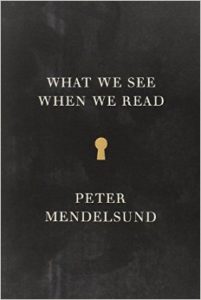It was a random find during a browse of the bookstore shelves in between soccer games at a tournament earlier this year. It’s also the reason why publishers invest in good design work, because a cover can sell a book. This one did.
The cover is simple. The content is provocative.
 What We See When We Read by Peter Mendelsund is the newest addition to my slowly-growing list of “must reads” for writers of all types: writers who publish, writers who blog, writers who are students with assignments, writers (looking at my own professional field) who shape theological narratives through church newsletters & sermons & liturgies & even committee reports.
What We See When We Read by Peter Mendelsund is the newest addition to my slowly-growing list of “must reads” for writers of all types: writers who publish, writers who blog, writers who are students with assignments, writers (looking at my own professional field) who shape theological narratives through church newsletters & sermons & liturgies & even committee reports.
Words matter.
It’s why I love Microstyle, the first and still favorite book on my “must read” list for writers.
It’s why I wrote Sacred Pause, a book that mines the creative depths of faith language in order to dust off our assumptions of which words mean what in Church life.
Words matter, and how we present our words matters. What We See When We Read (Vintage Books 2014) highlights this truth by examining the mystery of reading:
Once a reading of a book is under way, and we sink into the experience, a performance of a sort begins… We perform a book — we perform a reading of a book. We perform a book, and we attend the performance. (160)
Words create an experience for readers (also for hearers and for the writers themselves). As writers, we craft words together for a particular purpose, a certain tune, a dynamic flow. And yet we writers cannot guarantee that readers will experience words in the same way we intend them. We must do our best with words … and then let them go to another’s perception, to another’s translation.
(The Bible is not exempt from this encounter with readers. The words, no matter how holy, simply cannot remain stagnant or concrete during the act of reading.)
 What Happens When We Read plays gleefully with and wonders philosophically over the dimensions of reading. It challenges and illuminates. Its pages are dynamic, unexpected, and graphic.
What Happens When We Read plays gleefully with and wonders philosophically over the dimensions of reading. It challenges and illuminates. Its pages are dynamic, unexpected, and graphic.
It is a book worthy of adding to your bookshelves, where you can return to it over and again to refresh your appreciation of reading, writing, and the marvel of communication.
